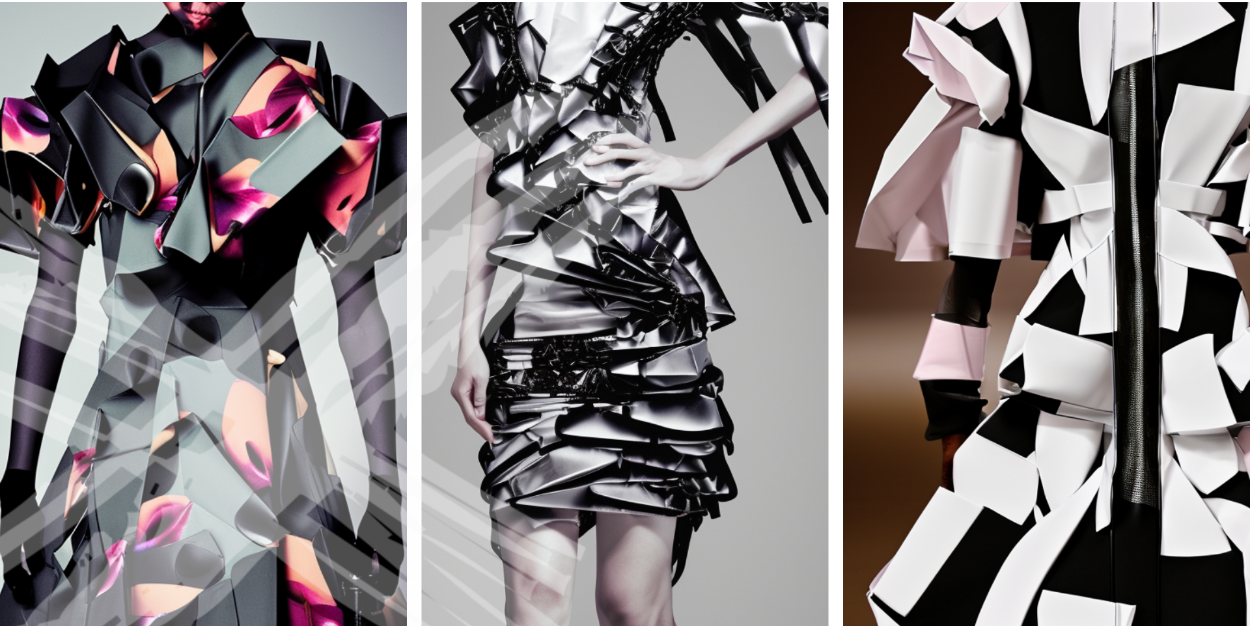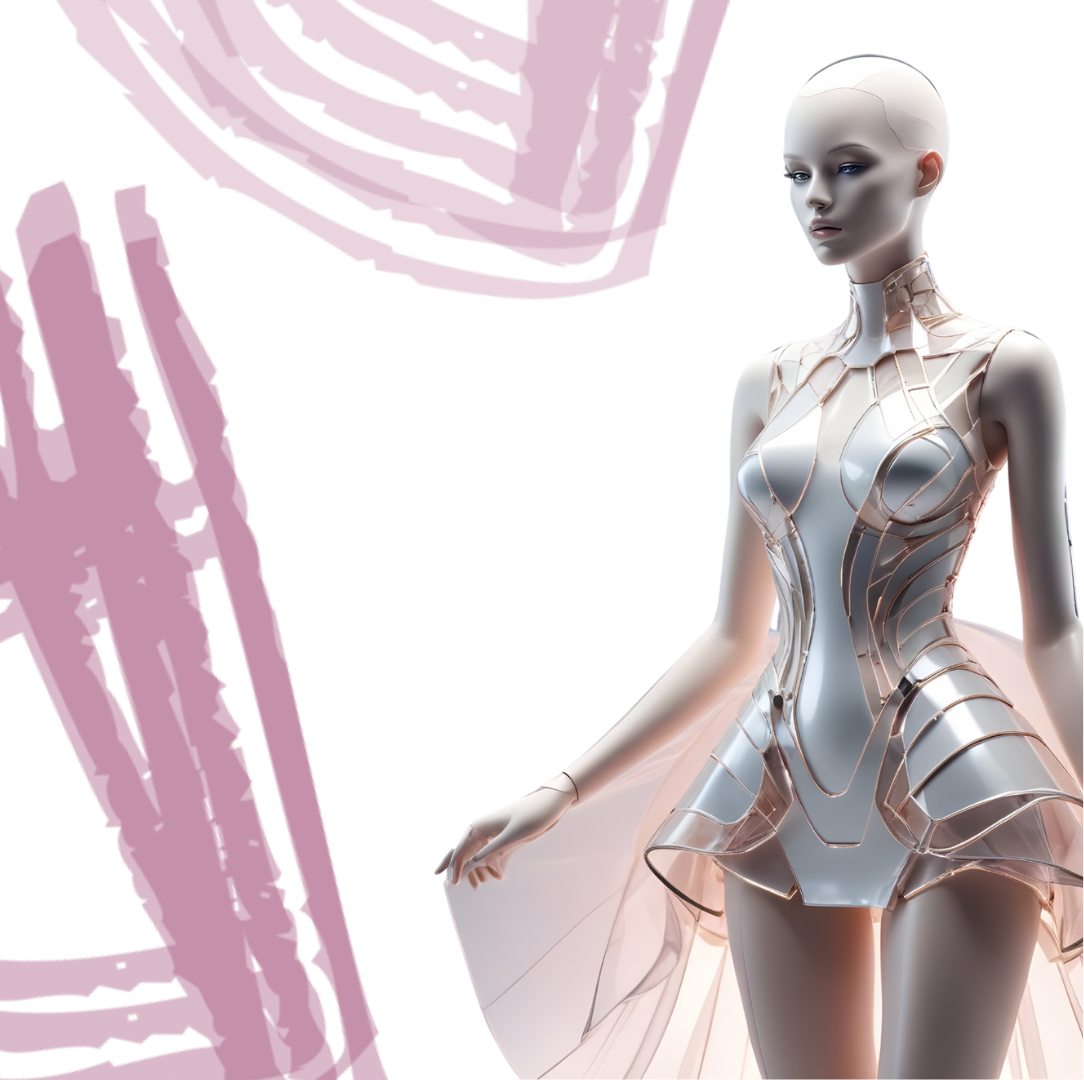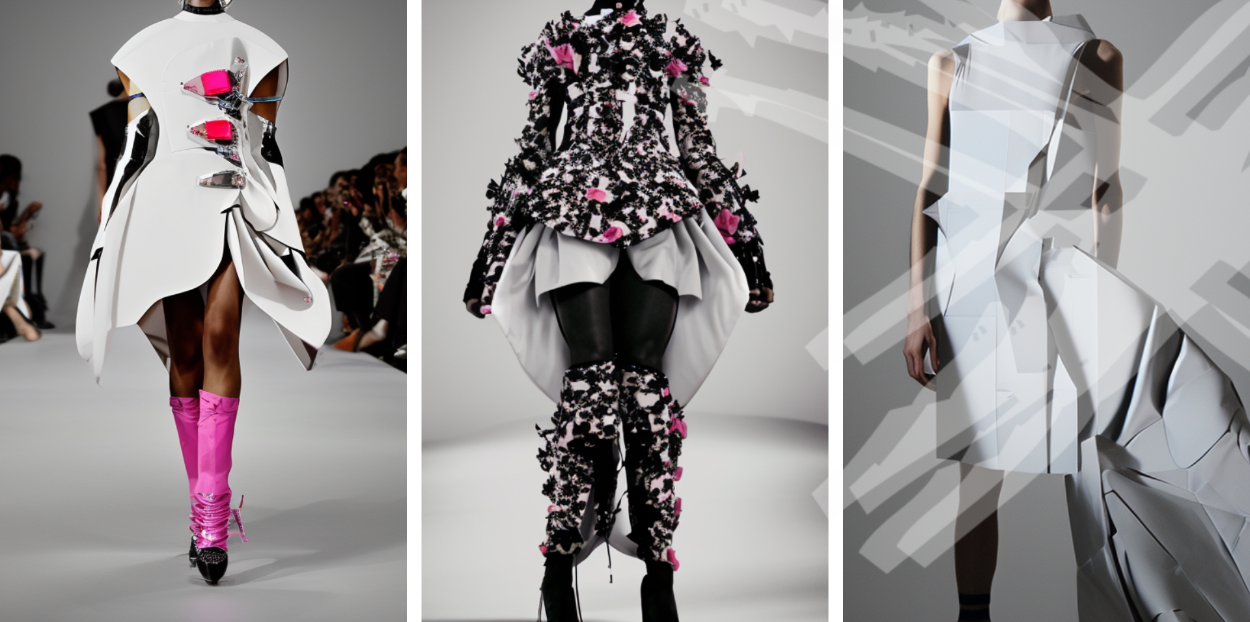This article was originally published in The Interline’s AI Report 2024. To read other opinion pieces, exclusive editorials, and detailed profiles and interviews with key vendors, download the full AI Report 2024 completely free of charge and ungated.
Key Takeaways:
- AI is moving from a niche technology to a mainstream tool in the fashion industry, and there is an increasing need for fashion education to integrate AI into their curriculums to prepare students for the rapidly evolving technological landscape.
- Despite the mixed feelings within the industry, many believe that AI can enhance creativity and productivity. However, there are also significant concerns about job displacement and the ethical implications of AI-generated content.
- While some fashion schools have started to incorporate AI into their programs, there is a concern that educational institutions may not be keeping up with the pace of AI advancements, potentially leaving future professionals underprepared for the demands of the industry.
Until recently, artificial intelligence (AI) in fashion has primarily been used for process optimisation and narrow, well-defined use cases in object recognition, inspection, product discovery and personalisation that kept it confined to technology departments at brands – and to computer science departments in education. But in 2022, AI surged into the mainstream thanks to the sudden public emergence of generative AI architectures, models, and applications – altering the status quo of fashion, and other creative industries alongside it.
While fashion brands and retailers might, on the surface, seem to be taking a “wait and see” attitude to AI, the reality is that a good proportion of businesses are actively trialling, experimenting with, and generally exploring the possibilities of AI – and finding ways to map that potential to a return on investment. The results of those pilots might be variable, but in-industry the broad parameters of AI are already being tested.
But when it comes to preparing the next generation to enter fashion’s workforce – it might be a different story. It’s obviously logical that education will lag behind the bleeding edge of technology innovation, but with AI changing things so comprehensively and so frequently, are institutions really equipped to close that gap in a meaningful timeframe?

If AI is truly reshaping the world of work, is education reshaping itself quickly enough to remain relevant?
New tools and the acceleration of AI
In 2021, OpenAI started beta testing GPT-3. In case you were wondering, GPT stands for “generative pretrained transformer.” “Transformer” is the neural network architecture that is at the core of most of today’s most powerful AI. The concept was originally published in 2017 in a paper entitled “Attention is All You Need” and the authors have 116,996 citations as of April 2024 – an unusually high figure that demonstrates just how transformational – forgive the pun – the underlying architecture was.
The overarching idea of this attention mechanism is that it learns what to focus on, allowing for long range connections (i.e., making links between words or tokens far apart in a piece of text). “Pretrained” refers to having learnt patterns in a dataset from unsupervised or self-supervised learning. This could be predicting masked words or the next word in a sequence. And lastly, “generative” refers to the models that can be used to create code, poetry, and other such language and writing tasks through the process of inference.
While not the first of its kind, GPT3 made waves by being the most powerful publically accessible model, and people became aware of that power in an extremely splashy way, after OpenAI built a chatbot interface on top of the model and released it to the public. OpenAI also released the first iteration of DALL-E: a tool that produced accurate captions – moving AI one step closer to understanding the visual world. Soon after, ChatGPT and DALLE-2 were made available to the public, as were other AI tools Midjourney, Stable Diffusion, Google’s Imagen AI, and Adobe Firefly. These could now be used by anyone to create new content, including audio, code, images, text, (and soon videos, with OpenAI’s upcoming Sora).
The creative industry reacted with a complex mix of amazement and fear. In a very short window of time, AI had changed from being a primarily of interest in R&D, narrow use cases, science, and academia, to being a free, widely-available set of tools that could generate output that straddled numerous creative fields. And while the initial releases of Midjourney et al did not exactly clear the bar for accuracy, realism, or consistency, later updates made it essentially trivial for end users to generate digital art, illustration, or “photography” that would often pass as being authentic.

In a study by Engine Creative on AI, many in creative industries agree that AI tools have the potential to play a role in acting as a springboard for ideas, and streamlining certain aspects of the creative process and could be used for inspiration. On the other hand, concerns arose in this survey – and this mirrors the general sentiment worldwide – around potential job losses for those not embracing AI, and being left behind by not being offered certain opportunities.
Here is where the root of AI anxiety and vertigo lies: AI has very rapidly been positioned as being something essential to learn and use, in fear of falling into irrelevance. But at the same time, the provenance of AI training data, and the deeps-seated feeling that creativity as a whole was being ingested, regurgitated, and resold, led to a very real and very visceral sense that the productivity and efficiency benefits of using AI were coming at a profound cost.
Intriguingly, in the Engine Creative study, many participants actually agreed that AI could force human beings to be more creative and productive. Designers in particular had a conflicted overall sentiment towards AI, with 60% believing that AI could support them in the future, but that AI and human work are too different to compare in terms of value. A further 18% of the surveyed designers believed that AI would have a negative impact on the creative industry, with most of them stating that AI will eventually be used to reduce costs and headcounts within businesses – bringing that existential fear to life.
Even though this is just one study, it seems to represent the overall ambivalence to AI in the fashion industry – where there is equal part optimism and scepticism. But all the same, the chances are that the next cohort of fashion creatives is going to be using AI in some capacity in their personal lives, even if it’s not for creative purposes. And there’s an even greater likelihood that by the time the new wave of designers, merchandisers, and marketers make it into the industry, the demand from employers will be for them to understand and be ready to use AI for a full suite of professional reasons as well.
Are fashion schools keeping up?
We have an idea about how the industry feels and the kinds of tools available to them now to use in their work. Bear in mind, this all happened over the last two years. But even prior to this, fashion schools were beginning to incorporate AI into their curriculums. In 2020, the Fashion Innovation Agency at London College of Fashion (LCF) launched an 8 week AI course for 20 volunteer fashion students to learn Python to write code to gather fashion data. This data would then be used to develop creative fashion solutions and experiences. The syllabus included: “Python programming, command line tools, Jupyter notebooks; writing a Python script to collect fashion data; training a model to classify items of clothing; training a model to predict fashion trends from social media; training a Generative Adversarial Network to create designs.”
Teaching the course was Pinar Yanardag, who is now an Assistant Professor at Virginia Tech in the Department of Computer Science. Before her current post, she was a postdoc at MIT, and received her Ph.D. in Computer Science at Purdue. No doubt, an exceptionally high level of technical proficiency and expertise for a course instructor, but also a potent example of just how far the skillsets of computer science, data science, and fashion now need to cross over.

“I introduced programming and state-of-the-art AI methods to fashion designers, and I believe that these skills are becoming essential in the industry,” Professor Yanardag told me. “The integration of technologies like AI into fashion necessitates a basic proficiency in programming. This knowledge not only enables designers to innovate and optimise processes from design through to retail but also enhances their ability to create customised, consumer-driven products through computational design.”
However, the selection of courses that are available today seem to have become less technical since then – possibly influenced by the widespread availability of the neatly packaged AI tools mentioned earlier.
The LCF course predated the release of ChatGT by two years, placing it firmly in the realm of AI as a scientific discipline, where narrow, focused applications were the model. Then the release of that landmark generative AI chatbot ushered in the era of what we might term more general AI – not in the sense that it is generally intelligent, but in the sense that the models are trained on an extremely broad dataset, given capabilities that transcend coding, art, writing, data analysis, conversation and much more.
This has undoubtedly been a major turning point for not just how society perceives AI, but how educational establishments and businesses think about it, and from my research it appears that fashion schools are still largely unsure how to incorporate this change into their curricula.
In writing this article, I reached out to 15 of the top fashion schools around the world, and the majority responded that they were not at liberty to comment on their teaching methods, course content, and classroom affairs. To me, this signals that there is so much going on with AI, and the capability window is so broad, that some – perhaps many – fashion schools are struggling to reckon with the move from AI as an easily-compartmentalised set of research projects, to AI as a general-purpose, industry and discipline-agnostic assistant.
In the wider world of consumer and enterprise technology, we see this same evolution: where AI was once reserved for specific applications, the world’s largest tech companies are now promoting general-purpose “copilots” and “agents”. What this means in practice for end users of technology, or creative, technical, or commercial professionals who use technology as a lever to assist in their work, is inherently difficult to pin down.

When AI is sold as being able to help you do basically anything, how does this affect an industry – education – where the goal is to provide people with the aptitude to do one thing well?
To evidence this, I have noticed a trend in the courses that have published their syllabi online, more towards the conceptual side of AI. For instance, at an institution called the Milan Fashion Campus, there is a course named “AI Fashion Design, Integration in Fashion Design Process” that has the following learning outcomes: understanding the fundamentals of Artificial Intelligence (AI) and its application in various fields, including fashion design; demonstrating the ability to utilise AI platforms such as ChatGPT, Midjourney, and NewArc for fashion design projects; exploring advanced prompting techniques, such as using image prompts and text prompts to enhance AI-generated designs; and how to apply AI in the virtual restyling of fashion items, and creating concepts for product photoshoots.
Along the same lines, the Fashion Innovation Agency also appears to have updated its syllabus for the more general purpose side of AI for fashion, as well as to recognise the divisive nature of its use amongst creatives . This now includes “exposure to empirical research and real-life case studies in order for participants to consider the potential for AI, and be able to make an informed decision around its application; exposure to the mechanics of AI in order to develop a sound understanding of the technology; how AI can help enhance creativity; how AI can assist in providing a more rounded omnichannel offering and assist with a greater global reach; and the ethics of artificial Intelligence.”
Other schools with programs in AI include Parsons School of Design at The New School, which has a variety of courses centring on AI. Two that stood out to me in particular were the “Exploring A.I. Through Art & Design” and “Generative Media And Artificial Intelligence: Digital Theories Of Autonomy And Alienation.”
These courses have a focus on the philosophical, historical, and fundamental understandings of AI and machine learning, as well as AI’s multidisciplinary origins and applications from an art and design perspective. Maya Georgieva, Senior Director, Innovation Centre – XR, AI & Quantum Labs at Parsons (The New School) explains that this contextual approach is intentional. “At the New School, we have a long history of addressing contemporary social issues, sustainability, and environmental impact,” she tells me. “I advocate for our students to not only experiment with AI in their projects but also to critically examine and, in some instances, challenge the capabilities and implications of these tools. Some of our students want to create projects with AI, and others want to do projects that expose or even break generative AI tools.” She has students’ whose opinions vary widely, from viewing AI-generated work as lacking authenticity, to appreciating the collaborative potential with AI.
This is a fascinating shift, from education covering AI as a practical, scientific subject when it was less widely-available and less generally capable, to education porting AI back into the realm of philosophy and cultural theory once it became clear that it was becoming (as our Editor puts it) “the next wave of consumer and enterprise technology”.
I think that the more conceptual approach does have its benefits for understanding the wider context of AI and its potential impact, as well as on how to use off-the-shelf AI tools. And I’m confident that it will help to produce more graduates who understand the broad philosophical parameters of AI and are equipped with the right grounding to help us navigate a future where the balance of human and machine work has shifted.

But if AI development and deployment continues to roll out at the pace it has been over the last eighteen months, are fashion schools moving the needle quickly enough on employability?
Benefits of a deeper understanding of AI
What fashion schools should try to avoid is creating a new generation of students who don’t have the first clue about how AI-tools work if they were to open up their hood. These skills don’t need to be on the level of a computer scientist, but there is likely to be a benefit to having digital skills that transcend the traditional skills that have been taught at fashion schools through the ages – referring here to fashion design, patternmaking, textiles, sewing and garment construction, draping, illustration, and marketing and merchandising – and that lead to a cohort of graduates that aren’t capable of just using AI, but also recognising its limits.
A large amount of effort amongst AI researchers is currently being invested in the field of interpretability – or building a concrete understanding of how large language models arrive at the outputs they do. And for young professionals who are likely to be asked to use generative AI when they do land in-industry, similar questions are going to arise. Why does AI do what it does? What can brands do to influence the way it behaves? What skills are truly necessary for not just obtaining results from AI, but actually understanding and being able to influence those results?
Another benefit of students having a solid grip on AI fundamentals is the ability to fix things when they are broken. Already, fashion brands are being forced to hire from outside the industry’s walls in order to interacting with APIs that hook into cloud-based, opaquely-trained large models leaves the user at the mercy of the software provider who may well have better things to do than handle your query.
Another tricky thing that fashion schools need to reckon with is the understanding that the best AI (as defined by the broadest set of general capabilities) is currently centralised in the hands of a few companies, and the temptation is, therefore, to merely use their products – and to focus educational courses on them. While valiant efforts have been mounted by the open source community, the company behind the popular open image generator Stable Diffusion is perhaps the poster child for the challenges in competing against some of the biggest and richest technology companies in the world – losing its CEO and exposing just how expensive large models can be to train and operate versus the limited revenue potential to be realised from users.
In that context, there is a clear argument for preparing students to use the “de facto” AI tools, since these appear to be cornering the market in both content licensing agreements (ensuring that they will retain access to new training data from key publishers and other sources) and, in a very recent move, resale partnerships with management consultants to provide more “penetration into industry verticals” according to OpenAI’s global head of alliances and partnerships. And when a particular solution reaches this stage of institutional adoption and entrenchment, it becomes effectively essential for people to learn.

But a lot can change in AI in a very short span of time, functionally and culturally – and if OpenAI’s ecosystem does not remain ahead of the pack, talent with transferable skills will become sought-after very quickly.
There is however an alternative future to centralised AI, one which I’m rooting for. In this future, fashion professionals and creatives would need to build more technical computer science-type skills, but they would be less reliant on massive, monolithic models to build them.
Although the open source community has, as I mentioned, struggled, there are still communities that are working to keep the power of AI in the hands of the many instead of the few.
HuggingFace, an AI company based in Paris and New York has emerged as a bit of an AI-era Robin Hood, as they publicly host a wide range of models, including large transformer models. This month, the number of models hosted on their site surpassed 1 million. These include text-to-image models, which designers can use to generate their own images – similar to DALL-E 2.
Why would fashion schools have any interest in these open source models as opposed to closed source models? The primary argument for open source models is that they’re free and community-maintained, so fashion schools will not need to be locked into working with a single AI-as-a-Service company.
And with open source models there is also the option of local deployment, provided students and creatives are given access to the right hardware to run diffusion or inference locally.
The employment endgame: fashion school education versus job market demands
It’s likely that fashion institutions are looking at the industry and the job market in order to make the decisions of how to design an updated curriculum that incorporates AI.
The key problem though, is that lag between industry roll-out and the speed with which a curriculum can be created and added to the institution’s list of degrees (measured in years) or the speed at which existing courses can be adjusted.
Although some universities and colleges are doing admirable work in making broad AI education available to their students, in general the next generation of fashion talent is not being taught the skills that they may need upon graduating in a competitive job market where their adversaries are not just fellow graduates but also AI models trained to either supercharge their efficiency (a dystopian phrase if ever there was one) or make them obsolete.

Against this backdrop, the students who will pull ahead upon entering the job market are those who are going the extra mile in their free time and acquiring technology-based skills that are relevant to a role they might apply for in future. These candidates with hybrid skills – of traditional fashion as well as AI and broader technology – are going to stand out and likely be chosen for the job.
“As technology becomes more ingrained in every aspect of fashion, those with a technical background are likely to have a competitive edge in the job market,” says Professor Yanardag. But as identified, education is lagging behind industry, so how to keep up? “Practical workshops and interdisciplinary projects can provide hands-on experience, while discussions on ethical considerations in AI ensure that future fashion professionals use technology responsibly” Professor Yanardag offers.
Maybe the most ideal teaching approach for a fashion school would include teaching the relevant AI tools for that particular set of traditional fashion skills, alongside more technical aspects like building neural networks, hyper-parameter optimisation, and learning how to navigate the ecosystem of open source models while tailoring them to one’s own needs.
Also included would be the ethical considerations around AI that intersect with sustainability and intellectual property rights. Compulsory reading may include the recent New York Times versus OpenAI lawsuit, where Times is accusing OpenAI of infringing copyright by training its large language models (LLMs) with Times content, and with the accusation that ChatGPT could, on command, replicate entire NYT works – suggesting that the model does “contain” by some definition a copy of those original works.
When it comes to sustainability, there is also still a lot that is not known about the environmental ramifications of using big models, but may be well worth fashion students being aware of, especially if they are going to be using them frequently.
Final thoughts
Fashion schools and their students find themselves at a uniquely complex crossroad. Schools need to consider how much to alter their courses to keep up with the zeitgeist, while ensuring that traditional skills are still taught – at a time when the cutting edge of technology is being redefined week by week, even if those capabilities are being built on top of shaky legal foundations that may threaten to collapse the entire AI house of cards if training models on unlicensed content is not found to constitute “fair use”.

Most fashion institutions, though, are still focused on teaching those traditional skills, and might provide a module or course on AI related to the particular skill – or some measure of crossover or collaboration for computer science students who are specifically dedicated to machine learning projects and ambitions. These schools are trying to ensure that new, buzzy industry topics don’t overshadow the importance of old-school techniques, but that the ones that will be critical for their students in the future aren’t omitted. It’s not an easy task.
As for students, they constantly compare what they are learning in their particular fashion school to what is happening in the fashion industry, and need to reconcile that they might need to do a lot of extra upskilling in their free time – anticipating what future fashion employers may want.
In the interim, we would love to believe that the reason so few universities were willing to go on the record about how they are teaching AI is that those focused courses are under active development, and competitive secrecy is a factor. But the more pragmatic perspective is that education, just like every other segment of fashion and the world at large, still is not sure what AI is going to look like when it reaches further along the maturity curve…
